Flexible Assembly Systems: Assembly by Robots and Computerized Integrated Systems
It has become clear in recent years from such major forums as the various international conferences on flexible manufacruring systems (FMSs) that the computer-controlled and -integrated "factory of the furure" is now being considered as a commercially viable and technically achievable goal. To date, most attention has been given to the design, development, and evaluation of flexible machining systems. Now, with the essential support of increasing numbers of industrial examples, the general concepts, technical requirements, and cost-effectiveness of responsive, computer-integrated, flexible machining systems are fast becoming established knowledge. There is, of course, much still to be done in the development of modular computer hardware and software, and the scope for cost-effective developments in pro gramming systems, workpiece handling, and quality control will ensure that contin uing development will occur over the next decade. However, international attention is now increasingly rurning toward the flexible computer control of the assembly process as the next logical step in progressive factory automation. It is here at this very early stage that Tony Owen has bravely set out to encompass the future field of flexible assembly systems (FASs) in his own distinctive, wide-ranging style.
1117472131
Flexible Assembly Systems: Assembly by Robots and Computerized Integrated Systems
It has become clear in recent years from such major forums as the various international conferences on flexible manufacruring systems (FMSs) that the computer-controlled and -integrated "factory of the furure" is now being considered as a commercially viable and technically achievable goal. To date, most attention has been given to the design, development, and evaluation of flexible machining systems. Now, with the essential support of increasing numbers of industrial examples, the general concepts, technical requirements, and cost-effectiveness of responsive, computer-integrated, flexible machining systems are fast becoming established knowledge. There is, of course, much still to be done in the development of modular computer hardware and software, and the scope for cost-effective developments in pro gramming systems, workpiece handling, and quality control will ensure that contin uing development will occur over the next decade. However, international attention is now increasingly rurning toward the flexible computer control of the assembly process as the next logical step in progressive factory automation. It is here at this very early stage that Tony Owen has bravely set out to encompass the future field of flexible assembly systems (FASs) in his own distinctive, wide-ranging style.
109.99
In Stock
5
1

Flexible Assembly Systems: Assembly by Robots and Computerized Integrated Systems
231
Flexible Assembly Systems: Assembly by Robots and Computerized Integrated Systems
231Hardcover(1984)
$109.99
109.99
In Stock

Product Details
| ISBN-13: | 9780306415272 |
|---|---|
| Publisher: | Springer US |
| Publication date: | 06/30/1984 |
| Edition description: | 1984 |
| Pages: | 231 |
| Product dimensions: | 6.10(w) x 9.25(h) x 0.02(d) |
From the B&N Reads Blog
